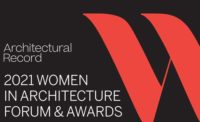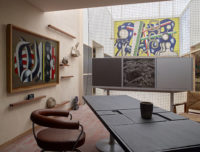Architecture exists in the absence of photography, but its vicarious experience through photography is the predominant way we learn about buildings and their unique attributes. Images are mobile; buildings are not. So of course, there is a correlation between the quality of the picture capturing a work of architecture and how the viewer comes to perceive it. Whoever photographs a work of architecture can make or break it, celebrate or condemn it. The image-maker leaves an imprint on the observer, shaping the understanding of the work across time, positioning it in the universe of references that makes up the history of the field.
Though architecture is inherently experiential—cinematic and fourth-dimensional—photography fixes the viewpoint: it cuts off the peripheral field of vision and frames space within the technological limits of its era. Those are objective facts of photography, but subjectivity is at play as well. The photograph carries the signature of its maker, who creates it to have a particular effect, which can reverberate far into the future.
Which photographer is commissioned has significant implications for both a building’s and an architect’s identity. When an architect hires a photographer, there is a high level of trust and a shared vision. The style of a photographer’s approach can have a profound impact on the architect’s future in the profession and the culture at large. The architect embraces the photographer’s ability to create the definitive architectural identity of the building. In many cases, the architect’s and the photographer’s legacies become intertwined.
In the 20th century, significant partnerships of architects and photographers have left a collection of images through which the greatest examples of modernist architecture are embedded. In the postwar era, Ezra Stoller (1915–2004) was the most influential image-maker in the United States. The design literature of that period is filled with iconic Stoller photographs. Hiring him in his heyday meant the architect would become integrated in Stoller’s own history—which included photographing the work of Marcel Breuer and Walter Gropius, and other legendary Modernists. It elevated the work of many of Stoller’s clients into the elite.
Stoller photographed much of the architecture of Wallace Harrison, Gordon Bunshaft, and Paul Rudolph, among others. Their projects, memorialized in pictures, are inseparable from Stoller’s craft. They were unofficial working partners. Other notable pairs of photographers and architects include Julius Shulman and Richard Neutra, Pedro Guerrero and Frank Lloyd Wright, Balthazar Korab and Eero Saarinen. The list expands, of course, around the world to such pairings as Lucien Hervé and Le Corbusier and, more recently, Yukio Futagawa and Tadao Ando.
Stoller’s photography reached for universal values in architecture, downplaying the fleeting desire for the excitement of the moment. His images are filled with pause, temporal suspension, contemplation, and emotional detachment. The gravitas of the building and the convictions of the architect’s design intent were the targets of his photography. His was an intense exercise in distilling the essence of the architecture before him. Absent was impulse, layering, and lighting effects superimposed on the existing space. When looking at the portfolio of the Tompkins House in Hewlett Harbor, New York, by Marcel Breuer, completed in 1946, Stoller’s visual rhetoric becomes apparent. In 55 images, mostly taken using only natural light, Stoller carefully documents every corner of the architecture. With the exception of two color images, the job is all in black-and-white. People are present only in nine images, and primarily for the interior. His camera steadily records the design expression of the project. The architecture is represented naked, without celebrating its materiality but rather the simplicity and economy of the project.
Stoller would arrive at the site and quietly study the building, experiencing its changes throughout the day. Then, he would establish a chart of viewpoints, to be meticulously followed the next day in executing his picture plan. The scale of the job would determine the time needed to thoroughly document the space. He read the architecture as it was, limiting to a minimum the use of artificial light. There is an invisible space between the architecture and the viewer, who is not invited to be part of the scene. Documentation, rather than a suggestion of participation—of being there—is part of Stoller’s approach to his photography. These visual hallmarks are traceable to grander projects too, such as his pictures for: the Gallery of Contemporary Art, at 2 Columbus Circle, New York, by Edward Durrell Stone; the St. Louis Airport, by Minoru Yamasaki; the Parking Garage, in New Haven, by Paul Rudolph; and the Banque Lambert, by SOM, in Brussels. These architects and their colleagues bought into the way Stoller saw architecture through his camera.
In counterpoint was the expressiveness of Los Angeles–based Julius Shulman (1910–2009). Joyful hedonism was a central trait in his photography. Leisure, lifestyle, pleasure, and a genuine desire to connect the elitism of the modernists to the general public were primary drivers of his pictures. His assistants became part of the scene. Drinks, fruit baskets, and plants were added to what was often a complete rearrangement of the furniture. This staging all built up to an alluring spectacle; Shulman intervened decisively to rewrite the design message of his photographic subjects. Filing off the sharp edges of the Modernist ideology was his aim; he wanted to make this new architecture user-friendly to those who may not have understood the avant-garde but wanted to live in modern times. His images are full of panoramas, night scenes, people lounging or partying—all the cues of the California dream for which he became a powerful ambassador. Photographing the Frey House I in Palm Springs, California, by Albert Frey, Shulman pulled out all the stops to celebrate the mechanical character of the house against the rugged natural backdrop of the California desert. The architect himself appears in a number of images, as does Shulman’s assistant, in swimming trunks, with a towel around his neck, next to the pool. The photographer’s focus on people in a carefree atmosphere elicits in the viewer a desire to be included. He used infrared photography in a few instances to further accentuate the architectural massing against the landscape. This approach is a big part of his photographic legacy, and it shaped the perceptions of the architecture of Richard Neutra, Rudolph Schindler, and many who were in the Case Study House program, helping to bring them popular acclaim.
A sizable part of the iconography of Frank Lloyd Wright’s late career can be credited to the pictures of Pedro Guerrero (1917 – 2012), who, for almost 20 years, recorded life in Taliesin West and in Wright’s projects beyond. Guerrero placed his camera in the midst of the architecture. The space is represented in its day-today existence, with the furniture arranged casually, and with few patterns of shadows. Architecture is depicted as friendly, lived-in space—antiheroic, anti-monumental—but the images are nonetheless rich in information. Absent is drama and the spectacularization of space via the camera. At Taliesin, Guerrero illustrated the actual story of an architect living in a design universe of his own creation, a portrait of a community gathered around a charismatic master.
Architectural photographer Yukio Futagawa (1932–2013) was for decades the visual vessel of modern architecture for his native Japan as well as for much of the rest of the world. Before he founded the publishing house Global Architecture (GA) in the early 1970s, he had already achieved an iconic status through the Contemporary Architects Series, for which he photographed the best of postwar American and European architecture. It is through Futagawa’s photography that the architectural cognoscenti witnessed the meteoric ascent of Tadao Ando. The architect’s and photographer’s sensibility were in alignment. Ando’s elemental architecture was an ideal subject for Futagawa, whose dramatic shadows and highly contrasted blacks and whites were as raw in the impact of Ando’s work as his renowned concrete surfaces. The photography was ascetic, confident, bold, invariably devoid of people, and focused in telling the story of an architecture founded on the certainty of Cartesian geometry. Absent is emphasis on cloud formations or hyper-attention on details, or acrobatic aerial views: the photographic narrative stays strictly with the architecture. Early projects like Rokko Housing One in Kobe, the Church of Light in Osaka, and the Church on the Water in Tomamu, Hokkaidō, were captured with a silent reverence for a modernity then in doubt under the wave of Postmodernism.
While photographs might be seen, by both photographers and their clients, as the visual record of the moment they were taken, they acquire a cultural status as beacons of a way of living or as reflections of an era that is increasingly independent of the circumstances that produced them. And photographs highlight the vulnerability of architectural memory. They are all that is left when a building is razed—but what happens to a piece of architecture when the building is destroyed and the photograph is damaged or lost? That architecture becomes unaccountable and, perhaps, for later generations, it is as if it never existed.
With the digital revolution and the ubiquitous use of smartphones to take pictures and post them on social media sites such as Flickr and Instagram, photography’s effects on the perception of architecture have grown exponentially. Along with the highly gifted photographers who continue to shoot the built environment today—many of them in continuous partnership with the same architects—an avalanche of snapshots disseminate architectural knowledge, shaped through time-dependent technology and the varying abilities of the individual image-maker. Yet the fact remains that architecture depends on photography, as fragmentary as its representation may appear, shifting the focus of the design field to image as opposed to experience.
Still, Stoller posited that a photograph is the best approximation of the real thing. And it still is.














Post a comment to this article
Report Abusive Comment